Mining for DNA: The search for new life begins at depth
Words by Kevin Brown
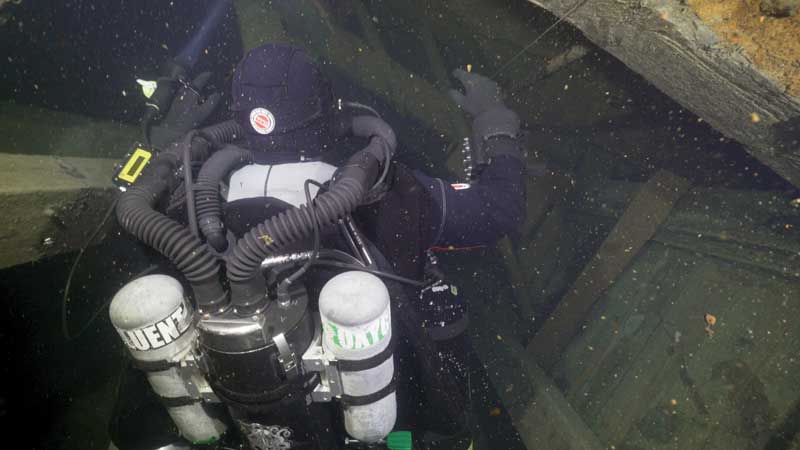
Our exploration of the abandoned cold water mine started first with a plunge into the archives. While the Outaouais region Quebec owes its development largely to heavy mining, our industrial heritage has not had much historical value placed on it, and very little documentation exists on the mines in the area or the work that took place there. With the help of The Gatineau Valley Historical Society, our dive team was able to find old pictures and rudimentary maps of our planned dive site, the Forsyth mine, but these no longer reflected the state of the mine. It quickly became clear that our own documenting of the passages would be key to the safety of our diving operation. We were there to collect DNA samples under extreme conditions, but the safety of the team was paramount.
The discovery of iron ore in the region is said to go back to the first survey of the area in 1801, when surveyor John MacTaggart saw the needle of his compass fluctuate in the proximity of what would eventually become the small mining colony. In 1854, the rights were sold to an American firm named Forsyth and Co., of Pittsburgh, Pennsylvania and the mine was renamed.
Forsyth and Co. ceased operating here in 1880 and the activities were taken over by Hull Iron Mines, Ltd. In 1957, the shaft was dewatered and the deeper sections of the mine were dug; the haulage tunnel with rails was to reach the depth of 200 feet (61 m) and the other deep tunnels were going to be connected via an elevator shaft that was sunk in 1959. This was the last known exploitation of this mine. We found maps that showed future development projects for this site, but they were particularly confusing, as we had no idea if they reflected the current state of the mine.
The mine and nearby village are now abandoned, 6.2 miles (10 km) northwest of Gatineau City. The site sits on the boundary of a new suburban neighbourhood. Nature has claimed back its own and vegetation occupies the remaining foundations of what used to be the miners’ houses.
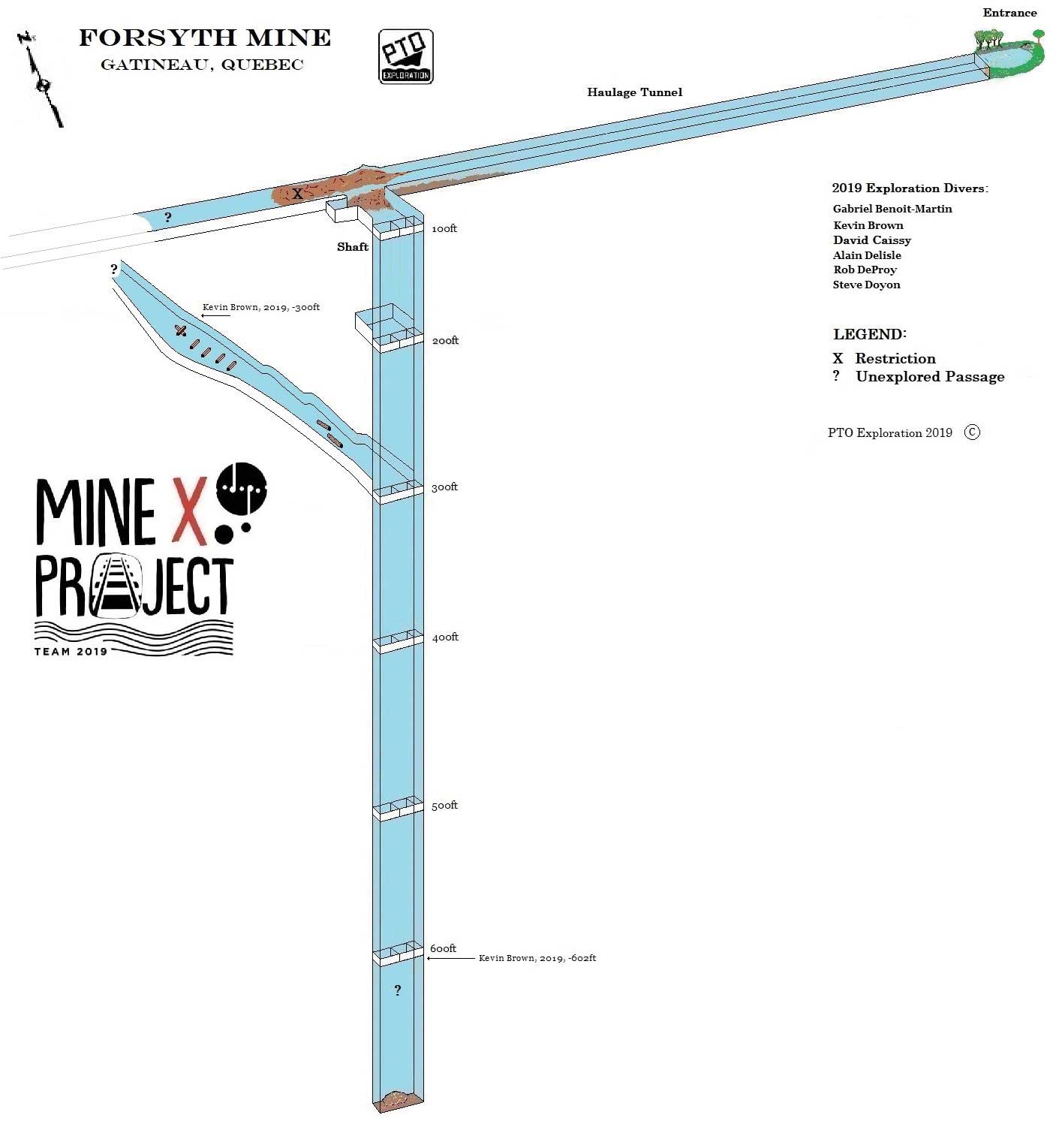
The Minex Project
The Outaouais region has many abandoned flooded mines with great potential depth and mostly unchartered tunnels. In light of this, we decided to build a project to explore, document, and study those unknown environments. The Minex project started two years ago with the exploration of virgin mines in the region.
This year’s exploration goal was Forsyth. As the aquatic environment has remained undisturbed since the mine closed, microbial communities have thrived and adapted to the unique conditions found in this underground ecosystem. This constituted a unique opportunity to explore and discover new life forms and rare micro organic communities in this atypical environment.
We collaborated with the University of Ottawa and University of Quebec in Montreal. The Explorers Club endorsed the expedition and sent us Flag 101, with the aim to assess microbiota diversity within the flooded mine ecosystem. A research permit was also secured with the proper authorities, as it is mandatory to dive this site. The goal was exciting: the collected data could possibly lead to important changes in the ways in which we understand the tree of life.
Additionally, the exploration of this underwater mine provided an opportunity to study deep diving in an anthropologic way—that is—what it does to someone’s humanity to be doing deep diving.
As divers, what we observed was fascinating: the formations that resembled to long stalactites algae from the ceiling, or the white filaments spread in a spider’s web, were surreal. The first thought that came to my mind was that it was algae growing, but after a discussion with the microbiologists I learnt that this would be impossible since there was no light—it was most likely a bacteria colony. We knew that things that grow without light, in 42 degrees (5.5°C) water, deep underground, and with little oxygen, would be resilient and possibly unique to this kind of environment. Studying and understanding the resilience of life in an environment that has been exploited by humans and abandoned when profit plummeted are timely. In those harsh conditions, finding new life forms at depth that have different metabolism mechanisms, could be of great importance for science.
With a team of five divers, we started collecting samples in July 2019; this task was particularly challenging due to the cold-water element and the large number of samples required to perform a credible analysis. A total of 26 person-dives were conducted to collect samples between 20 feet (6.1 m) and 602 feet (183.5 m).
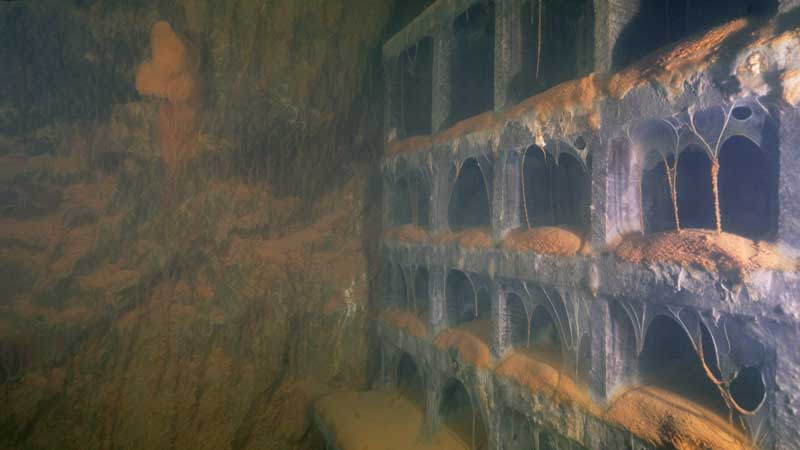
600-foot Dive
After a full year of preparation for this deep dive, I entered the mine on July 20th. Visibility was no more than six feet (1.8m) so I followed the intact train track for guidance. After only about 400 feet (122 m) of penetration, I passed the first restriction: a small squeeze between an industrial pipe and the silt leading to the elevator room. The main haulage tunnel was clogged by years of accumulation of sediment. That old dual elevator cage, which miners used to lift the minerals, was the only way to access the deeper levels of the mine. Every 100 feet (30.5m) down, another lateral tunnel branched out from the elevator shaft.
Earlier in the project, during my first dive in that shaft I had been anxious; we thought that the mining company had sealed the elevator shaft from the surface with a concrete slab, but I had no way of testing the stability of the potential underwater land fill. I knew that the bubbles from my rebreather would accumulate and create pressure under the slab, possibly causing some parts to collapse and seal shut my only way out. On my first descent, some of the wood planks came loose and fell on my head, which was not so critical on that dive. However, if that were to happen in a dive on which I had accumulated six hours of decompression in 42 degrees (5.5°C) water…a single nail from those planks could rupture my drysuit and put me in a difficult situation, having to choose between severe hypothermia or a decompression accident; both could lead to death before exiting the mine. There was no way I could stay in water this cold for over an hour in a leaking suit, even with heated undergarments. This is the risk that I had to accept to make this dive.
I started my descent into the shaft. Everything that I could plan had been planned, everything that could have been practiced and rehearsed had been so. As I passed the 150-foot (45.7 m) mark, the visibility improved to about fifty feet (15m). I had previously dived it and installed a line up to 450 feet (137m), but descending another 152 feet (46.3 m) would be challenging since the shaft’s unstable structure was filled with debris, rocks and metal cables—objects that could rupture my equipment—creating multiple restrictions along the way. I needed to analyze and memorize every single detail on the way down because I knew that on the way up, purging my suit and rebreather from such depth would create a whirlpool of silt, making it a zero-visibility exit.
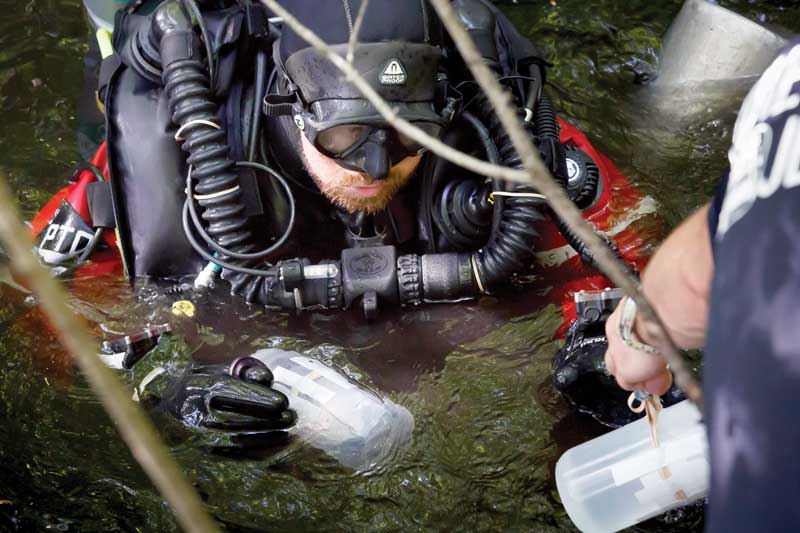
In the Shaft
Passing the 500-foot (152m) level, I observed a section of the shaft where the wood structure was caving in. There was no time for debate here, since I was accumulating significant decompression time, so I decided to bypass it and continue.
I finally reached my planned depth of 602 feet (183.5 m). The laborious descent took more time than I anticipated due to unforeseen restrictions so I would have only a few minutes at this depth. Everything was dark. The wooden structure appeared to be burned from a fire—or perhaps it was bacteriae that produced this effect. I pulled out the syringes to gather the DNA samples. I could feel the high-pressure neurological syndrome (HPNS): my hands were unsteady and my eyes were having difficulty focusing—further complicating the laborious sample collection with my dry mitts.
Shortly after, I started my long ascent in total silence, with only the clicking of my solenoid to reassure me. As predicted, the silt started falling, forming a dense cloud and I began my excruciatingly long decompression in the frozen water at around 450 feet (137.2 m) of depth—a long way from my safety divers Alain and Gabriel. After a total of 6 hours and 13 minutes, I surfaced with the precious samples without any incident. Exhausted, Gabriel helped me exit the water.
In the end, we explored the elevator shaft to 602 feet (183.5 m) as well as the tunnels at the 200-foot (61m) level and the 300-foot (91.5m) level. When the visibility was at its best, we could see that the 200-foot (61m) level consisted of a big room approximately 50×30 feet (15x9m) with a few industrial materials lying around.
Towards the end of the project I explored the 300-foot (91.5m) level, but because of the difficulties running a reel with dry mitts and the lack of available attachment points to tie the cord onto, I only made it to about three quarters of my planned penetration. As the research permit was expiring, I could not return and confirm the end of the tunnel, although I did collect enough remote samples.
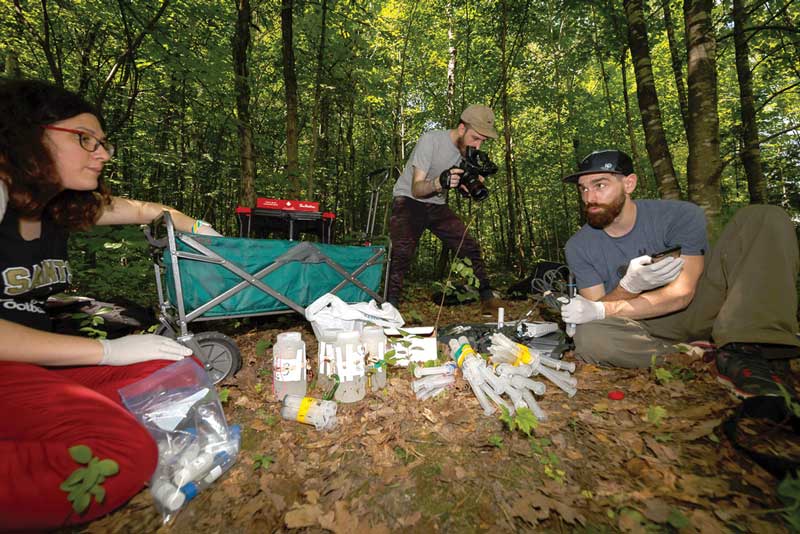
Great Potential
Due to lack of time and logistical complications, the 400-foot (122m), 500-foot (152m), and 600-foot (183m) levels remain unexplored. There is also one section of the main haulage tunnel past the elevator shaft that was obstructed with silt and we choose not to disturb it. We believe that the exploration dive at 602 feet (183.5m) in 42ºF (5.6ºC) water sets a new world record for deep diving in cold water mine (autonomous—that is, without a decompression environment). At this time no further exploration of the mine is planned.
This exploration allowed researchers to collect a total of 33 water samples and 62 biofilms (gelatinous matrices secreted by microorganisms to assist in their survival). Genetic material (DNA) present in the samples was then extracted at the University labs, and these are now waiting to be sequencing. DNA sequencing allows researchers to precisely identify the family of microorganisms present in each sample, which deepens our understanding of the range of biodiversity present in the unique ecosystem.
Preliminary results on DNA concentrations are promising. We expect to find well-established non-phototrophic (do not use light for energy) microbial communities within the mine. Furthermore, the variety of biofilm forms observed and sampled gives hope for the discovery of new microbial species.
During the next year, biology Ph.D. candidate Francis Comte will bring some of the samples to the University of Texas to perform a metagenomic and bioinformatics analysis. This will allow the researchers to identify all the genes present in a given sample and expose the metabolic diversity of the mine’s ecosystem. Since DNA sequencing can’t identify previously unknown microbes, the metagenomic methods will palliate for that.
This exploratory study will advance our understanding of microbial development in underground, aquatic man-made environments, and the discovery of new microbe species might challenge the current tree of life.
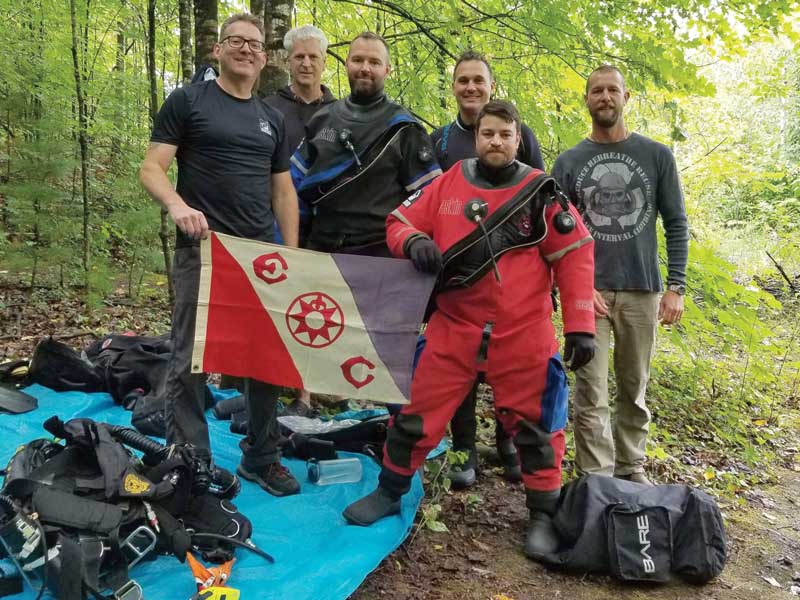
The author would like to thank the Canada Research Chair (CRC) in Aquatic Genomic as well at the HumAnimaLab (HAL) for the support and contribution to this expedition.
Team members that contributed to the project and this article: Alain Delisle, Ayesha Ratnayake, Cassandre Lazar, Chantal Bergevin, David Caissy, David Jaclin, Francis Comte, Gabriel Benoit-Martin, Guy Allard, Jules Valeur, Kevin Brown, Luc Gilbert, Nicolas Rutherford, Robert DeProy, Serge-Olivier Rondeau, Steve Duplessis, and Steve Doyon.
Leave a Comment







